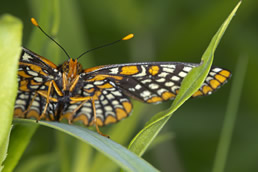How To Photograph Butterflies
Part Two

Photographing Butterflies
Part Two: Cut to the Chase!
The Approach: Stealth & Cunning
Flowers can’t run and hide, but you will need to exercise some stealth in order to successfully photograph butterflies and other live insects.
While some butterflies are actually more approachable than you might think, sudden motion will startle most butterflies from a dozen feet away or more. Smooth and steady movements are always the way to go.
Whether you’re in a suburban garden or the most remote corner of Timbuktu, consider the angle you want to shoot from before you approach—but think fast, because your subject is not likely to stay right where it is for long.
Ideally, for even illumination of the butterfly’s wings in natural light, you will want the sun directly above the subject, or over your shoulder. (If you’re using a macro flash, this will be less of a concern.) Shooting into the sun is worth considering too, but if you’re just getting started, you might want to wait until you’ve had more experience. In any case, you should approach from whichever angle you choose with smooth, careful but deliberate movements. You probably shouldn’t walk right up to your subject the way you’d approach the bank teller.
Carefully navigate around the obstacles while being conscious of where your shadow will fall. Most butterflies will take to wing by reflex if your shadow passes over them.
If other plants are in your path, try to place your feet so as not to trample them. Not only might you damage the environment, often the bending plant causes a chain reaction, nudging the butterfly’s perch ever so slightly, spoiling your opportunity.
Keep in mind that there may be Poison Ivy, Snakes, Wasp nests—maybe even Alligators in some areas. Try not to take your eyes of your quarry for long or you might lose sight of it. They have a habit of flying away if you divert your attention for an instant, and if you didn’t see which way they went, you might not find them again.
Sometimes even when you don’t directly disturb your quarry, you’ll startle a tree frog, grasshopper or some other creature in your path. Grasshoppers are expert at determining where you’re coming from and jumping in the exact opposite direction. Nine times out of ten, if there are grasshoppers between you and your target, one of them will land right on top of the butterfly you’re trying to shoot.
Shoot First—Ask Questions Later!
When photographing butterflies, I always recommend that you shoot first and ask questions later. Take your first shot from a farther distance than you would prefer, then take more exposures as you move in closer.
I try to get at least one exposure as soon as I’m close enough to record the moment. This is insurance, in case the target spooks or simple flits off to another area and I never see it again. At least I have a photographic record of the sighting and the habitat that might contain valuable scientific information. When I’ve downloaded those images, I frequently find things I was totally unaware of when I took the picture.
Some butterflies never stop moving—hovering around blossoms or scrambling around a flower head, probing each floret for no more than an instant. In many cases, you have no idea what the best shot will turn out to be until you’ve uploaded your images onto a computer. There are subtle differences that make one exposure a huge success and the next frame, “meh”. A slight shift of position can make a huge difference. Take a lot of pictures and you’ll increase the odds that you’ll capture the best moment.
You never know how long the butterfly will stick around, so if you’re too patient, you can miss the whole opportunity when the butterfly randomly flies away without notice.
Butterflies are individuals and unpredictable, but some species do exhibit some degree of predictable behaviour. In time you will get to know your quarry and recognize these patterns. Some species will take off and leave the area completely at the slightest disturbance, never to be seen again. Some will fly up into a tree and stay there motionless until you leave. Others zip out of sight, but return to the same or a nearby perch if you wait for them. Others are more likely to move a short distance and allow you to advance until you invade their comfort zone again. You can usually tell if a butterfly has been startled by your presence or if it’s just moving on to another flower. If you’ve startled it, you might want to be a little more cautious on the next approach.
Some butterflies actually seem to become more comfortable with your presence over time, and tolerate a closer approach on subsequent attempts. I’ve found this with other insects too. Keep trying; they often reward your perseverance. After a while they might recognize that you’re not a threat, so don’t give up easily.
Don’t expect miracles on your first attempt. Hopefully you’ll be pleasantly surprised and encouraged by the results you get.